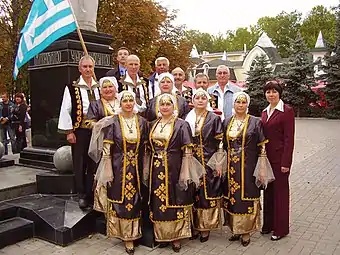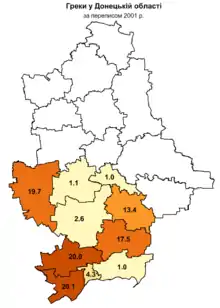Mariupol Greek
Mariupolitan Greek, also known as Rumeíka (Rumaiica, from Greek: Ρωμαίικα, "Romaic"; Russian: Румейский язык; Ukrainian: Румейська мова), is a Greek dialect spoken by the ethnic Greeks living along the northern coast of the Sea of Azov, in southeastern Ukraine; the community itself is referred to as Azov Greeks. Although Rumeíka, along with the Turkic Urum language, remained the main language spoken by the Azov Greeks well into the 20th century, currently it is used by only a small part of Ukraine's ethnic Greeks.[1]
| Mariupolitan Greek | |
|---|---|
| Rumeíka | |
| Native to | Ukraine |
| Region | Northern coast of the Sea of Azov |
| Cyrillic | |
| Language codes | |
| ISO 639-3 | – |
| Glottolog | mari1411 |
| Linguasphere | 56-AAA-ak (?) |

History
The Crimea was Greek-speaking for more than a thousand years as a part of the Byzantine Empire. After the Fourth Crusade's sacking of Constantinople fragmented the Byzantine Empire, the Crimea became a principality within the Greek Empire of Trebizond. When that state, which was centered on the eastern Black Sea coast and Pontic Alps of northeastern Anatolia, fell to the Ottomans in 1461, the Crimean Greek principality (Principality of Theodoro) remained independent, becoming subject to the Ottomans in 1475. The beginning of large-scale settlement of Greeks in the steppe region north of the Sea of Azov dates to the Russo-Turkish War (1768–74), when Catherine the Great of Russia invited Greeks of the Crimea to resettle to recently conquered lands (including founding Mariupol) to escape persecution in the then Muslim-dominated Crimea.[2]
Due to the centuries of living under the Tatar and Turkish rule, many of the Greeks did not speak the Greek language anymore; thus the community was divided into the Greek-speaking Romeiis and the Turkic speaking Urums (see Urum language).
In the 20th century, the Rumeíka was the Greek dialect used by most Greek-speaking villages in the North Azov Sea Coast region. There are about 17 villages that speak this language today. Modern scholars distinguish five subdialects of Rumeíka according to their similarity to standard Modern Greek.
The Rumeíka is not the only Greek variety spoken in the northern Azov regions: the village of Anadol speaks Pontic proper, being settled from the Pontos in 1826.[3]
Dialectal affiliation

Quite often Rumeíka is described as a Pontic dialect. According to modern researchers, the situation is not as simple: arguments can be brought both for Rumeíka's similarity to the Pontic Greek and to the Northern Greek dialects. In the view of Maxim Kisilier, while the Rumeíka shares some features with both the Pontic Greek and the Northern Greek dialects, it is better to be considered on its own terms, as a separate Greek dialect, or even a group of dialects.[3]
Research and literature
After the October Revolution of 1917, a Rumaiic revival occurred in the region. The Soviet administration established a Greek-Rumaiic theater, several magazines and newspaper and a number of Rumaiic language schools. The best Rumaiic poet Georgi Kostoprav created a Rumaiic poetic language for his work. This process was reversed in 1937 as Kostoprav and many other Rumaiics and Urums were killed as part of Joseph Stalin's national policies. A large percentage of the population was transported to Gulags.
The Rumeíka dialect became subject of linguistic study in the late 1920s and 1930s, as part of the general program of identifying and describing languages of the USSR.[3] However, linguists studying the language became victims of Stalin's repressions by 1937, and the research on the Rumeíka did not resume until the 1950s and 1960s.[3]
Scholars of Greek from Kiev, led by Andriy Biletsky compiled a detailed description of the language and recorded the folklore. As the Azov Greeks had apparently lost literacy in Greek already during the Crimean period of their history, a Cyrillic writing system, based on the Russian and Ukrainian Cyrillic was developed for them. [1]
A number of books have been published in the Rumeíka Greek using this Cyrillic orthography. Besides native works, they included translations of the Lay of Igor's Campaign and of Taras Shevchenko's Kobzar.[1]
A new attempt to preserve a sense of ethnic Rumaiic identity started in the mid-1980s. Though a number of writers and poets make use of the Cyrillic Rumeíka alphabet, the population of the region rarely uses it; the majority of self-identified ethnic Greeks of Ukraine now consider Russian their mother language.[1] The Rumaiic language is declining rapidly, most endangered by the standard Modern Greek which is taught in schools and the local University. Nonetheless, the latest investigations by Alexandra Gromova demonstrate that there is still hope that elements of the Rumaiic population will continue to use the dialect.[4]
See also
- Mariupol#Language structure, for the overall linguistic situation in the region
- Varieties of Modern Greek#Other outlying varieties
- Poetry of Leontij Kyrjakov in Rumaic language
Notes
- Pakhomenko, S.P., Література греків Приазов'я та проблема збереження культурних традицій грецької етнічної групи (1960-1980-ті рр.) (PDF) (in Ukrainian) (Literature of the Azov Greeks and the problem of the preservation of the cultural traditions of the ethnic Greeks)
- "Greeks of the Steppe". The Washington Post. 10 November 2012. Retrieved 25 October 2014.
- Kisilier, Maxim, Is Rumeíka a Pontic or a Northern Greek Dialect?
- Kissilier, Maxim, ed. (2009), Language and Ethno-Cultural Situation in Greek Villages of Azov Region (PDF), St. Petersburg. The work is based on field research in the Greek villages in Mariupolis region. The expeditions were carried out in 2001–2004 and were organised by St. Petersburg State University